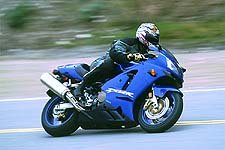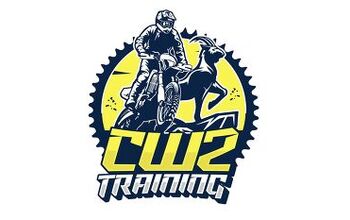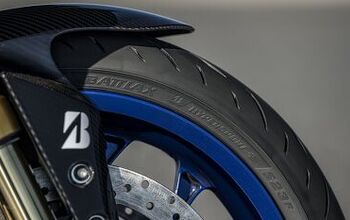First Ride: 2002 Kawasaki ZX-12R - Motorcycle.com
Monterey, California, February 20, 2002 -- Speculation and wishing will get you nothing but disappointment. Our case study? That'd be the introduction of Kawasaki's then-new Super Size sport bike in the Y2K, the ZX-12R.
Suzuki had the Hayabusa, and it was absolutely tits. It had the highest top speed of any production bike and the quarter-mile times to match. It would be a tough act to follow, but Kawasaki was confident of its new machine, and the advertisements and general media hype indicated a changing of the guard. But then, much to the chagrin of the two-wheeled press (not to mention Kawasaki US), the suits in Japan started making decisions that affected things that should have been left alone.
The result? Before it even came to dealers' floors, the highly anticipated ZX-12R was - for all intents and purposes - stillborn.
The two largest print magazines ran the two heavyweight contenders through the usual gamut of tests and diagnostics. The result? The 12R fell short of expectations, and no amount of hype could overcome that disappointment. And though quite a few units were sold, there was no way to fix the damage that had been done.
It's now two years later, and Kawasaki is once again certain its ZX-12R will be an absolute smash. You see, they've changed tactics mid-stream, or so we think. Where they used to tout the bike's still-impressive horsepower and torque numbers, these figures seem to get second billing nowadays, just aft of the stuff that says something about additional user-friendliness and increased wind protection.
To show the press just what changes have been made to the flagship model, and to illustrate that these changes have, indeed, been a step in the right direction, we were flown to beautiful Monterey, California. Yes, the same town whose boundaries include that heavenly bit of pavement known as the Pacific Coast Highway. Oh, you thought we'd say Laguna Seca? That's not what this bike's about, old chap. Speedy travel on sinewy backroads, however, is the new bike's forte', and the coastal road was just the place to prove it to a bunch of jaded journos such as ourselves.
Externally, the bike doesn't look much different than before. About the only visual clues that jump out at you are the new colors and the windscreen which is now 20 millimeters taller. But once you're on board the new bike, things have a familiar ring to them. Though the handlebars are now situated a few millimeters lower, the feeling is familiar. There's a lot of bike beneath you, and the raspy idle hints at the power lurking beneath.
Leaving the parking lot of our seaside hotel, getting the bike moving is a no-brainer. The re-worked clutch and the amount of grunt available just off idle makes short work of leaving a light. And though we haven't had our test bike on the drag strip as of yet, a few impromptu drag launches confirmed a lot of positive feel at the lever. There wasn't any sign of fade or slipping after repeated launches, either.
"Between the big motor and the long, stable chassis, there's a feeling of imperviousness that comes over you as you ride through a twisty stretch of road at a rapid clip."
Heading down the coast on a brisk and slightly damp morning, the taller windscreen is a most-welcome change as it puts the majority of the wind-blast just over the shoulders of our tallest (six-feet, two-inches tall) tester. Another welcome change is the motor that has received a bit of refinement compared to the previous version. The internal changes, which have given the bike better low-end power, more reciprocating mass and smoother acceleration, make riding the ZX-12R down the coast an absolutely serene experience. From the first time we were able to twist the throttle, we were awed by the amount of smooth and linear power on tap.
Enjoying the scenery at a leisurely 65 mph in top gear, there are no intrusive vibes coming through butt, hands or feet. And as the throttle gets rolled on and cruising speeds increase, there's only one real spot of vibes to mention. Right at 75 mph, things are a bit vibey, though they're not intrusive or annoying by any means. They're just noticeable because the rest of the power band is so smooth. By the time you get into another section of vibrations, you're well into the triple digits and have more important things to worry about.
Tipping into the first in a series of twisty bits of two-lane, the big Kawasaki feels remarkably nimble, though it's by no means light. Getting it turned requires a transfer of weight or a solid shove on the inside bar to get things moving in the requested direction. It's physically a big bike, so the steering inputs are greater than what is normal for even an open-class sport bike like the Yamaha YZF-R1, but they're by no means difficult for a rider of average-strength.
"It certainly gave us the confidence needed to keep up a seriously quick pace by using the bike's stability and huge motor to drive us into the next bend."
Between the big motor and the long, stable chassis, there's a feeling of imperviousness that comes over you as you ride through a twisty stretch of road at a rapid clip. Heaving the bike from side to side requires effort, though you're rewarded with a large amount of feedback from both contact patches. What they tell you, time and again, is that you're doing just fine. About the only clue that the bike may be less than thrilled at your aggressive antics is the oscillation of the suspension.
The 12R's boingers have a tough chore, more so than most. There is a lot of weight they have to keep in check, and Kawasaki's engineers have done a pretty good job of things, but there's still room for improvement.
One of the changes Kawasaki made to the suspension is a stiffer front end, "to combat front-end dive," they say. But we'd gladly take a bit of dive and weight-transfer to the front end in place of the somewhat choppy feel of the stock front end. To get things to settle to our liking, and to better match the comparatively soft back end, we backed out one turn on the compression adjusters.
We left the rebound damping adjustments alone up front, though we did add a touch of compression and rebound damping to the rear. The end result of these changes is a more balanced ride. The chassis now feels more planted than it did before through abrupt left-right-left changes and mid-corner ripples at high lean angles. With the suspension changes made, everything stayed planted and on-line as it should. It certainly gave us the confidence needed to keep up a seriously quick pace by using the bike's stability and huge motor to drive us into the next bend.
High-speed sweepers are this bike's reason for being, though you can have some fun in the tight stuff, too. Coming down Pacific Coast Highway, we were totally content to let the big blue bike chug along in sixth gear, even down to 45 mph. The 12R has such copious amounts of torque and, mated to the best fuel-air mixers ever fitted to a Kawasaki, you really don't need anything but first and sixth gears to make rapid progress on this bike.
On the brakes after a long straight, you're reminded how large of a bike this Kawasaki is. Still, getting it slowed is never a concern as the revised Tokiko brakes do a wonderful job of getting things slowed down. Of course, the lever requires quite a tug to get seriously rapid deceleration, but that's to be expected. Thankfully, modulation of the binders, both front and rear, is quite easy since they provide excellent feel.
Despite the fact that we could run through miles of corners and straights in one gear, the Kawasaki's six-speed box is wonderfully precise and shouldn't be ignored.
Changing up or down was always clean, and there wasn't a missed shift to be had, with or without use of the clutch.
By the time we'd finished our photo shoot and continued our nighttime drone down the interstate, back into Los Angeles, we were going on a solid 10 hours of seat time on the new Kawasaki.
We'd seen an average fuel consumption of about 32.8 mpg over the course of the day, and in the following days spent commuting, that figure has changed little. It's a thirsty beast, but an impressive one that churns out the most power of any stock bike we've strapped to our dyno. The thing about this new ZX-12R is that, despite all its performance potential, it's a terrific all-around machine. We wouldn't hesitate to put a tank bag or some soft luggage on it and make a two-day, four-state tour, stopping at a few drag strips along the way. Kawasaki has done a wonderful job of refining its biggest bike, and at a suggested retail price of $10,999 US dollars, it's a lot of bike for the money.
Is it better than Suzuki's Hayabusa? We can only say it's going to be a very close call when we get the two bikes side-by-side.
Specifications
Engine: 4-stroke, DOHC, inline fourDisplacement: 1,198ccBore x Stroke: 83.0 x 55.4mmCompression ratio: 12.2:1Cooling: LiquidFuel injection: 46mm throttle bodiesIgnition: DigitalTransmission: 6-speedFrame: Aluminum monocoqueRake/trail: 23.5 degrees/3.7 in.Suspension, front: 43mm inverted hydraulic telescopic fork w/ 12-wayadjust compression and rebound damping, adjust spring preloadSuspension, rear: UNI-TRAK® system w/ single shock, 20-way adjustcompression and rebound damping, adjust ride heightWheel travel, front: 4.7 in.Wheel travel, rear: 5.5 in.Tire, front: 120/70x17 tubelessTire, rear: 200/50x17 tubelessFront brake: 320mm dual hydraulic discsRear brake: 230mm single hydraulic discOverall length: 81.9 in.Overall width: 28.5 in.Overall height: 46.7 in.Ground clearance: 4.7 in.Seat height: 31.9 in.Dry weight: 463 lbs.Fuel capacity: 5.3 gal.Wheelbase: 56.7 in.Colors: Pearl Mystic Black/Metallic Crescent Gold,Passion Red/Pearl Cosmic Grey
More by Motorcycle Online Staff


































Comments
Join the conversation